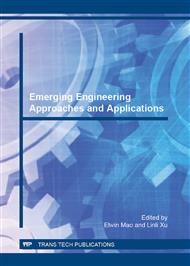p.375
p.381
p.387
p.395
p.400
p.405
p.411
p.416
p.421
Empirical Mode Decomposition De-Noising Method Based on Improved Soft-Threshold
Abstract:
In this paper, an improved soft-threshold function is constructed, combined the improved function and empirical mode decomposition (EMD) methods, a new de-noising method has been proposed. Set the adaptive threshold for the intrinsic mode functions (IMFs) of the EMD, and then de-noise the each IMF respectively. Finally, the de-noised signal is reconstructed by the de-noised IMF components. Through the simulation results of quantitative analysis by signal-to-noise ratio (SNR) and mean square error (MSE), the algorithm in this paper has better de-noising effect. Also, this method can effectively improve the constant deviation between the original signal and the de-noised signal by traditional soft-threshold.
Info:
Periodical:
Pages:
421-425
Citation:
Online since:
September 2011
Authors:
Permissions:
Share:
Citation:


